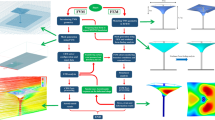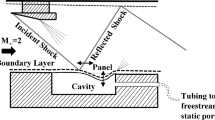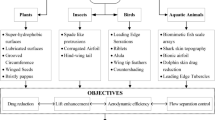Abstract
The development of shock tubes and understanding of shock wave propagation and its interaction with a model is of significant interest in various domains. In this context, shock tubes effectively recreate the field explosion in controlled laboratory conditions and ensure safety, low cost and repeatability. The blast wave simulators (BWS) are operated in a reflective (for barrier wall, blast absorbent material, etc.) and diffractive (for biofidelic head and torso, In-vivo, etc.) mode. The side wall reflections in refractive mode and end wall reflections from the model in reflective mode shock tube cause secondary loading to the model. In this study, a reflection wave eliminator (RWE) with a flap assembly was developed to minimize secondary loading in closed-end shock tubes, and its performances are discussed. As the first cycle of shock wave crosses the RWE, it will open the flap assembly and helps in minimizing the successive cycles of shock waves. The effect of RWE location and the number of flap openings on shock wave parameters, such as positive peak overpressure and impulse, for the case of two different shock tubes length, such as 3.3 m and 5.3 m, has been studied. It was observed that the peak overpressure reduction in the secondary shock wave because of single flap RWE at the model location is 71.31% and 88.12% for 3.3 m and 5.3 m long shock tubes, respectively. The secondary loading of the model in closed-end shock tubes can be significantly reduced by tuning the standard shock tube using the RWE proposed in this study.













Similar content being viewed by others
Data availability
Data will be made available on request.
References
Vieille P (1899) Sur les discontinuités produites par la détente brusque de gaz comprimés. Comptes Rendus 129(1228):68
Fomin N (2010) 110 years of experiments on shock tubes. J Eng Phys Thermophys 83(6):1118–1135
Glass I, Patterson G (1955) A theoretical and experimental study of shock-tube flows. J Aeronaut Sci 22(2):73–100
Ieshkin AE, Danilov A, Chernysh V, Ivanov I, Znamenskaya I (2019) Visualization of supersonic flows with bow shock using transversal discharges. J Vis 22(4):741–750
Ram O, Geva M, Sadot O (2015) High spatial and temporal resolution study of shock wave reflection over a coupled convex-concave cylindrical surface. J Fluid Mech 768:219–239
Reshma IT, Vinoth P, Rajesh G, Ben-Dor G (2021) Propagation of a planar shock wave along a convex-concave ramp. J Fluid Mech 924:A37
Treanor C, Skinner G (1961) Molecular interactions at high temperatures. Planet Space Sci 3:253–256
Downes S, Knott A, Robinson I (2014) Towards a shock tube method for the dynamic calibration of pressure sensors. Philos Trans R Soc A 372(2023):20130299
Saravanan S, Jagadeesh G, Reddy K (2009) Aerodynamic force measurement using 3-component accelerometer force balance system in a hypersonic shock tunnel. Shock Waves 18(6):425–435
Tasissa AF, Hautefeuille M, Fitek JH, Radovitzky RA (2016) On the formation of Friedlander waves in a compressed-gas-driven shock tube. Proc R Soc A 472(2186):20150611
Friedlander FG (1946) The diffraction of sound pulses I. Diffraction by a semi-infinite plane. Proc R Soc Lond Ser A 186(1006):322–344
Chandra N, Ganpule S, Kleinschmit N, Feng R, Holmberg A, Sundaramurthy A, Selvan V, Alai A (2012) Evolution of blast wave profiles in simulated air blasts: experiment and computational modeling. Shock Waves 22(5):403–415
Obed Samuelraj I, Jagadeesh G (2018) Shock tubes: a tool to create explosions without using explosives. Blast Mitig Strateg Marine Compos Sandwich Struct 2018:337–356
Kochavi E, Gruntman S, Ben-Dor G, Sherf I, Meirovich E, Amir B, Shushan G, Sadot O (2020) Design and construction of an in-laboratory novel blast wave simulator. Exp Mech 60(8):1149–1159
Sundaramurthy A, Chandra N (2014) A parametric approach to shape field-relevant blast wave profiles in compressed-gas-driven shock tube. Front Neurol 5:253
Colombo M, Di Prisco M, Martinelli P (2011) A new shock tube facility for tunnel safety. Exp Mech 51(7):1143–1154
Panzer MB, Matthews KA, Yu AW, Morrison B III, Meaney DF, Bass CR (2012) A multiscale approach to blast neurotrauma modeling: part I-development of novel test devices for in vivo and in vitro blast injury models. Front Neurol 3:46
Cernak I, Merkle AC, Koliatsos VE, Bilik JM, Luong QT, Mahota TM, Xu L, Slack N, Windle D, Ahmed FA (2011) The pathobiology of blast injuries and blast-induced neurotrauma as identified using a new experimental model of injury in mice. Neurobiol Dis 41(2):538–551
Sundaramurthy A, Alai A, Ganpule S, Holmberg A, Plougonven E, Chandra N (2012) Blast-induced biomechanical loading of the rat: an experimental and anatomically accurate computational blast injury model. J Neurotrauma 29(13):2352–2364
Sundar S, Ponnalagu A (2021) Biomechanical analysis of head subjected to blast waves and the role of combat protective headgear under blast loading: a review. J Biomech Eng 143(10):100801
Belov E, Blachman M, Britan A, Sadot O, Ben-Dor G (2015) Experimental investigation of the stress wave propagation inside a granular column impacted by a shock wave. Shock Waves 25(6):675–681
ASCE: blast protection of buildings, Asce/sei 59-11 edn, pp 1–108 (2011). American Society of Civil Engineers. DOIurlhttps://doi.org/10.1061/9780784411889
Ismail A, Ezzeldin M, El-Dakhakhni W, Tait M (2020) Blast load simulation using conical shock tube systems. Int J Prot Struct 11(2):135–158
Rigby S, Knighton R, Clarke S, Tyas A (2020) Reflected near-field blast pressure measurements using high speed video. Exp Mech 60(7):875–888
Isaac O, Jagadeesh G (2020) Impulse loading of plates using a diverging shock tube. Exp Mech 60(4):565–569
Toutlemonde F, Rossi P, Boulay C, Gourraud C, Guedon D (1995) Dynamic behaviour of concrete: tests of slabs with a shock tube. Mater Struct 28(5):293–298
Commerford GL, Whittier JS (1970) Uniaxial-strain wave-propagation experiments using shock-tube loading. Exp Mech 10(3):120–126
Kuriakose M, Skotak M, Misistia A, Kahali S, Sundaramurthy A, Chandra N (2016) Tailoring the blast exposure conditions in the shock tube for generating pure, primary shock waves: the end plate facilitates elimination of secondary loading of the specimen. PLoS ONE 11(9):0161597
Gan ECJ, Remennikov A, Ritzel D, Uy B (2020) Approximating a far-field blast environment in an advanced blast simulator for explosion resistance testing. Int J Prot Struct 11(4):468–493
Oakley J, Bonazza R (2004) xt. exe Wisconsin Shock Tube Laboratory (WiSTL) code. University of Wisconsin, Madison
Anderson JD (1990) Modern compressible flow: with historical perspective, vol 12. McGraw-Hill, New York
Acknowledgements
The authors would like to thank the Structural Engineering Laboratory in the Civil Engineering Department, Indian Institute of Technology Madras (IITM), Chennai for this research facility. The authors are grateful to Prof. G Rajesh (Rarefied Gas Dynamics Laboratory, IITM), for fruitful discussions and support. The help received from Mr. M. Vijay Vanaraj and Mr. Janarthanan in conducting the experiments is gratefully acknowledged.
Funding
Funding was provided by Science and Engineering Research Board India (Grant Number SRG/2019/001126).
Author information
Authors and Affiliations
Corresponding author
Ethics declarations
Conflict of interest
The authors declare that they have no known competing financial interests or personal relationships that could have appeared to influence the work reported in this paper.
Rights and permissions
Springer Nature or its licensor (e.g. a society or other partner) holds exclusive rights to this article under a publishing agreement with the author(s) or other rightsholder(s); author self-archiving of the accepted manuscript version of this article is solely governed by the terms of such publishing agreement and applicable law.
About this article
Cite this article
Kaviarasu, K., Sundar, S.S. & Alagappan, P. A Novel Method to Minimize Secondary Loading in a Closed-End Shock Tube. J. dynamic behavior mater. 9, 286–299 (2023). https://doi.org/10.1007/s40870-023-00384-9
Received:
Accepted:
Published:
Issue Date:
DOI: https://doi.org/10.1007/s40870-023-00384-9




